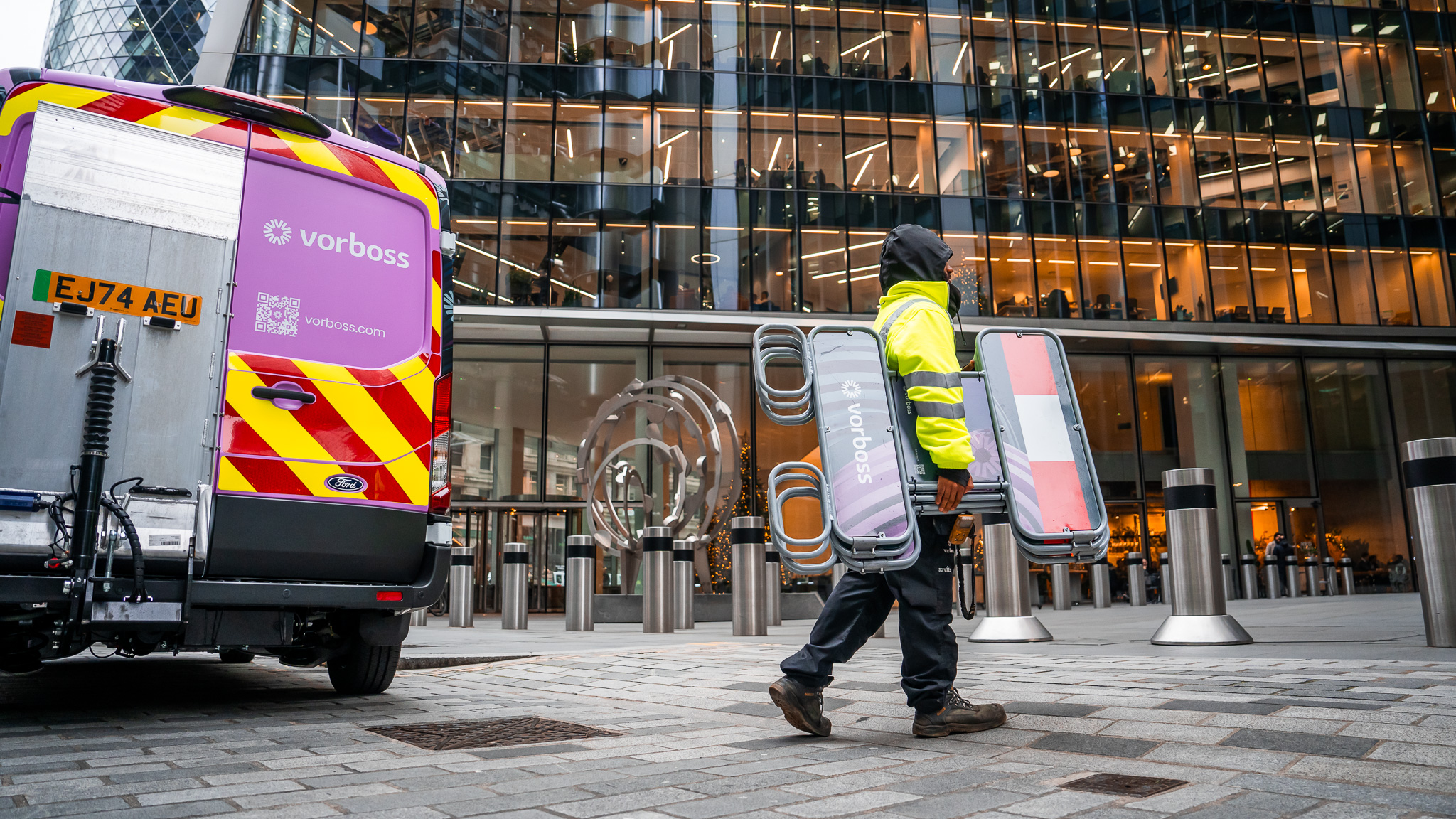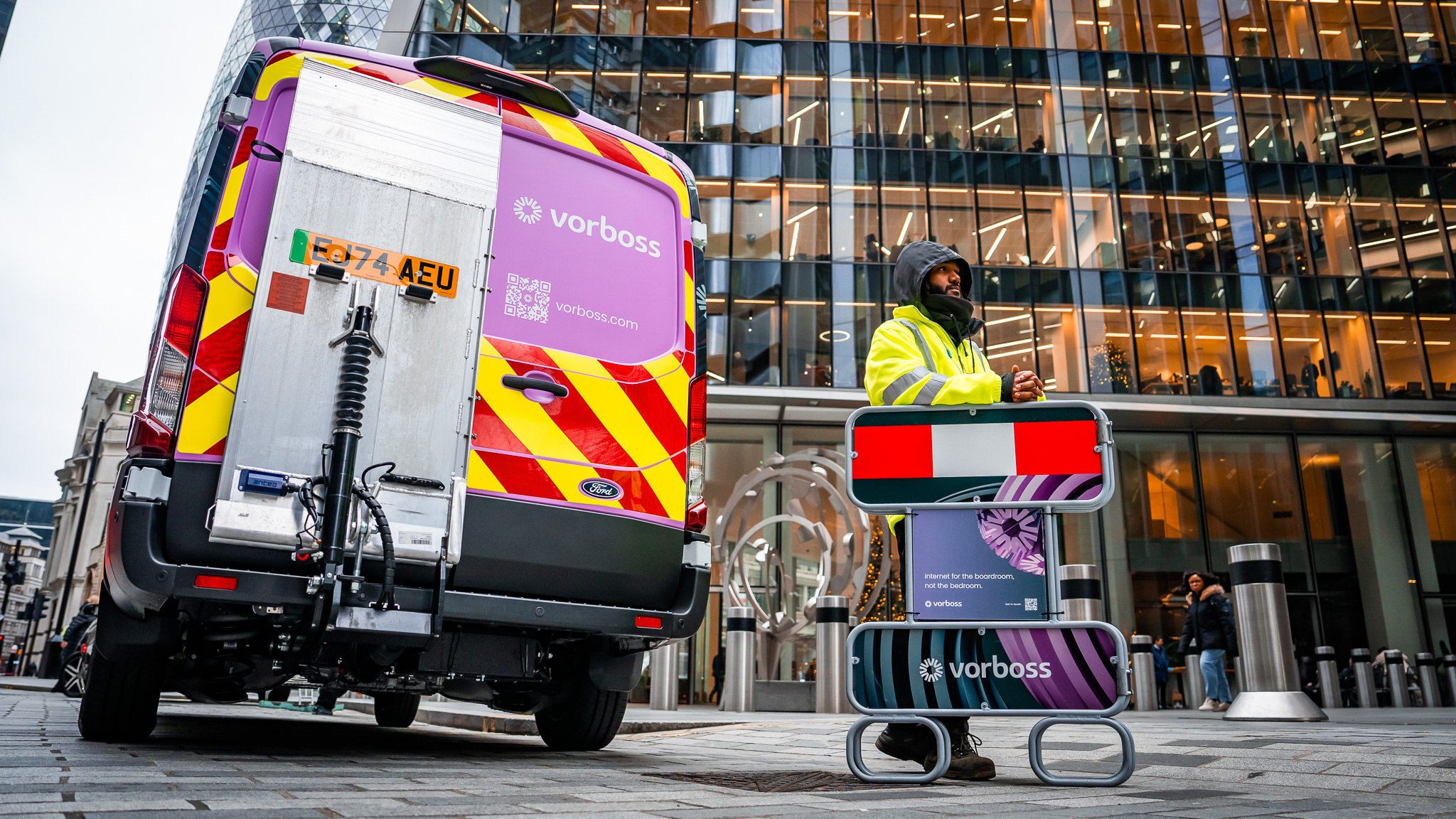Vorboss expands managed service and cybersecurity offerings, closes three strategic acquisitions


For many landlords and building managers, the word “wayleave” feels like the responsible route whenever a fibre circuit is being installed on their property. It sounds formal and safe – a neat legal box to tick.
In many cases, however, a wayleave adds unnecessary complexity and delays, frustrates tenants, and can expose landlords to long-term legal risks.
At Vorboss, we’ve connected thousands of office spaces across London without a wayleave, keeping landlords in full control and getting tenants online faster.

What is a wayleave?
A wayleave is a written agreement between a landowner and a telecoms operator. It gives the operator permission to install and keep equipment on private property.
What many people don’t realise is that signing a wayleave also activates “Code rights” under the Electronic Communications Code. These rights go beyond simple permission, they give the operator legal powers to stay on the property indefinitely, access it when needed, and even refuse removal of their equipment in certain situations.
For a typical connection into a commercial building in London, a wayleave can make the fibre installation process slower, more expensive, and limit the landlord’s flexibility long term.
Why a wayleave isn’t required for standard in-building fibre connections
For a standard in-building fibre connection serving a tenant, a wayleave isn’t a legal requirement. Important protections, like building access, fire safety, repairing any damage, and removing equipment, are already covered by the tenant’s lease and usual building rules.
If no wayleave is signed, no Code rights are triggered, meaning the landlord retains full control and the installation exists under a simple, fully revocable licence.
In practice, this gives landlords far more protection and flexibility:
- No legal lock-in – the telecoms operator has no long-term rights to stay or refuse removal.
- Landlords keep full control – equipment can be moved or removed when the building changes.
- Faster fibre installation – no time lost in drafting contracts or solicitor reviews.
- Happier tenants – connections go live quicker; tenants get to move in faster.
By contrast, signing a wayleave and granting Code rights introduces a complex and expensive legal process for any fibre removal or relocation. This can take at least 18 months, plus potential court or tribunal proceedings, making it slower, and far less flexible for the landlord.

Public services across central London are evolving, and the City of London Corporation is leading the way.
Whether you work, live or study in the Square Mile, you’ll soon feel the difference that faster, more dependable connectivity brings.

What is the Future Network Programme?
The City of London Corporation is rolling out the Future Network Programme, a major project to modernise its entire digital infrastructure and bring everything under one unified network.
From offices and schools to iconic green spaces like Hampstead Heath, cultural destinations like the Barbican, and historic markets such as Leadenhall and Old Spitalfields, this upgrade will mean more reliable connectivity across the City’s buildings and public spaces.
It also extends to essential services, including critical sites run by the City of London Police. This enhanced connectivity will support everything from secure communication systems to faster, more resilient networks for emergency operations.
Leading this transformation is Roc Technologies, supported by Juniper Networks and Palo Alto Networks; all powered by the Vorboss fibre network. Together, we’re bringing the City onto a modern digital foundation that’s ready to support its future.
Who the Future Network Programme benefits and how?
The programme is designed for everyone who depends on public services in the Square Mile:
- Students in City-run schools will have fast, reliable connectivity to fully access digital learning tools.
- Public-sector teams will experience smoother hybrid working, better access to online platforms, and more efficient collaboration across locations.
- Residents and visitors will see improvements in public Wi-Fi, digital services, and online access in libraries, community hubs, and other shared spaces.
- The City of London Police will gain a more secure, faster and resilient network that enhances CCTV reliability and enables more effective frontline operations.
.avif)

When Flight Centre, the unforgettable-experience-plotting travel experts, were preparing to open a brand-new shopfront on Upper Street in central London, everything was going to plan. The team had lined up suppliers early, including their internet provider, expecting smooth sailing to launch day.
Unfortunately, their installation was delayed, and the team kept chasing answers. Eventually, they learned the duct was collapsed and their chosen provider couldn’t fix it in time.
Grounded? Not for long
With just two weeks to go, Flight Centre had to act fast. They turned to Vorboss. In just over a week, the new shopfront was live and connected through Vorboss’s Rapid Install service.
Thanks to Flight Centre’s leadership and coordination across their teams in Europe and Australia, everything came together, and the store opened right on time.

“The collapsed duct was an unexpected challenge after months of delays with our previous provider. Vorboss stepped in quickly, took control, and kept things on track, ensuring the installation stayed on schedule despite the setback.”
-Tim Head, Global Service Delivery Head, Flight Centre
.avif)
So good, they brought us to Barcelona
The experience made such an impact that Flight Centre brought Vorboss into another project, this time in Barcelona. Using a local partner, they added another circuit for their new office. The line tails into the Vorboss infrastructure in Barcelona and links all the way back to the London network.
“Vorboss’s impressive internet service and customer experience gave us the confidence to bring them into further projects. Having a consistent connectivity partner across locations simplifies management and supports our growth.”
-Tim Head, Global Service Delivery Head, Flight Centre

London, 5 November 2025
Vorboss, London’s leading business fibre network, today announces the launch of a cutting-edge connectivity product built to enable essential public services across the capital.
The new solution offers high-speed, reliable connectivity that’s both affordable and quick to deploy, helping London stay connected and future-proof.
Built on the 100Gbps-capable Vorboss network, the new solution delivers ultra-reliable, high-capacity connectivity that underpins the growing demands of smart city technology and public infrastructure.
With a range of options to connect these end-points, the product enables councils, transport authorities, and service integrators to easily connect and manage thousands of devices, from real-time traffic cameras, CCTV, small cells, and environmental sensors to IoT-connected street furniture, all with enterprise-grade resilience and low latency.
“We have been listening to local government organisations over the last year as they explain their difficulty in finding cost-effective, reliable solutions to connecting machines across their boroughs. Through a lot of consultation and innovation we have been able to create a fibre-based solution that is reliable and can be installed quickly.”
Jason O'Malley, CCO, Vorboss, notes:
“With this launch, we’re extending the power of the Vorboss network to enable local authorities and service providers to make cities safer, and more efficient.”

Vorboss’s fibre network, which spans over 700km, is engineered for scalability and security. Our engineers are all based in Central London and are managed by a Liverpool Street based planning and NOC team. This provides an unparalleled level of proactive and reactive support to London's councils.
Rhod Morgan, Vorboss COO, adds:
"The density and quality of our network in central London puts us in a unique position to provide these innovative solutions. Every month 100s of new businesses are being connected to the Vorboss network and this is natural progression of the business as we further accelerate this growth."
About Vorboss
Vorboss is London’s most advanced business fibre network, designed to meet the connectivity needs of modern enterprises and critical public infrastructure. As a member of the Fern Trading Group (part of Octopus Investments), Vorboss is focused on empowering organisations with direct, high-capacity fibre that supports innovation and growth.

.png)
A fast-growing footprint and a move to a new London HQ, InPost is going through exciting changes.
If you’ve ever picked up a parcel from a locker at your local supermarket or petrol station, chances are you’ve used InPost. Founded in Poland and now operating across nine countries, they’re a leader in logistics solutions for the e-commerce industry in Europe.
Preparing for the move
The team knew that moving offices and switching internet providers can bring unexpected hurdles, so finding a partner who could provide dependable service and simplify the installation process was essential.

Q4 is crunch time, with businesses pushing hard to hit year-end targets. But nothing slows momentum like lagging connectivity. For teams, that often run across hybrid setups using cloud apps, this often means slow file transfers, dropped video calls, and frustrated employees trying to get work done. Every minute of downtime is a minute of lost productivity.
The hidden cost of downtime
Our Reliability and Compensation Report shows that 51% of UK fixed business connectivity customers report experiencing an outage annually, and nearly 1 in 5 have more than three outages.
These disruptions cost the average business around £11,000 in lost output.
Even worse, over 60% of those affected didn’t receive any compensation, either because claiming it wasn’t worth the effort or they didn’t expect to get anything back. So, while cheaper connections might look appealing on paper, they carry hidden operational costs that far outweigh any upfront savings.
How bandwidth directly impacts productivity
As more teams use AI-driven tools to speed-up tasks, poor connectivity becomes counteractive. These tools rely on fast, stable bandwidth to process and return results in real time. When responses lag, workflows slow, and the efficiency gains AI is designed to provide are reduced.
Most businesses only realise their network limits when they need it most, Q4 is the perfect example! Yet many teams have simply learned to put up with it. After years of slow uploads and dropped calls, it’s easy to accept that’s just how things are. But it doesn’t have to be that way. There is a choice, and switching to a more reliable connection is simpler than most realise (to us, anyway).

Fix problems now before they get worse
Addressing performance issues now ensures your team finishes the year strong and starts the next one even stronger. With reliable bandwidth, files transfer instantly, video calls stay clear, and systems remain responsive, so your team can focus on what really counts, getting work done.
Even if everything seems fine today, your team’s bandwidth demands are growing rapidly. Nielsen’s Law shows that high-end users’ network speeds increase by roughly 50% each year, so now’s the time to check whether your current contract can support the upgrades your team will need to avoid future slowdowns.
Latest from the press room

London, 5 November 2025
Vorboss, London’s leading business fibre network, today announces the launch of a cutting-edge connectivity product built to enable essential public services across the capital.
The new solution offers high-speed, reliable connectivity that’s both affordable and quick to deploy, helping London stay connected and future-proof.
Built on the 100Gbps-capable Vorboss network, the new solution delivers ultra-reliable, high-capacity connectivity that underpins the growing demands of smart city technology and public infrastructure.
With a range of options to connect these end-points, the product enables councils, transport authorities, and service integrators to easily connect and manage thousands of devices, from real-time traffic cameras, CCTV, small cells, and environmental sensors to IoT-connected street furniture, all with enterprise-grade resilience and low latency.
“We have been listening to local government organisations over the last year as they explain their difficulty in finding cost-effective, reliable solutions to connecting machines across their boroughs. Through a lot of consultation and innovation we have been able to create a fibre-based solution that is reliable and can be installed quickly.”
Jason O'Malley, CCO, Vorboss, notes:
“With this launch, we’re extending the power of the Vorboss network to enable local authorities and service providers to make cities safer, and more efficient.”

Vorboss’s fibre network, which spans over 700km, is engineered for scalability and security. Our engineers are all based in Central London and are managed by a Liverpool Street based planning and NOC team. This provides an unparalleled level of proactive and reactive support to London's councils.
Rhod Morgan, Vorboss COO, adds:
"The density and quality of our network in central London puts us in a unique position to provide these innovative solutions. Every month 100s of new businesses are being connected to the Vorboss network and this is natural progression of the business as we further accelerate this growth."
About Vorboss
Vorboss is London’s most advanced business fibre network, designed to meet the connectivity needs of modern enterprises and critical public infrastructure. As a member of the Fern Trading Group (part of Octopus Investments), Vorboss is focused on empowering organisations with direct, high-capacity fibre that supports innovation and growth.

London, 17 July 2025
Vorboss, London’s leading fibre network built exclusively for business, today announced the expansion of its managed services portfolio, reinforcing its position as the trusted single provider for the city’s enterprise connectivity needs. This strategic move reflects the growing demand for comprehensive, resilient services from a single, expert partner – particularly in light of the increasing complexity of cybersecurity threats and IT infrastructure.
- London businesses can now consolidate connectivity, managed services, and cybersecurity, backed by the fastest fibre network built exclusively for businesses
- Completed acquisitions of 40fi (cybersecurity) and Optimity (managed services), and strategic investment in Layer8 (network management for commercial real estate)
- 80+ new specialists join Vorboss, expanding total workforce to nearly 400
As part of this strategy, Vorboss has closed three acquisitions designed to broaden its capabilities beyond its core strength in managed network infrastructure. Among these are 40fi, a respected cybersecurity business, and Optimity, a leading provider of managed IT services. Together, these acquisitions bring an additional 80 experienced professionals into the Vorboss team, significantly enhancing the company’s ability to deliver end-to-end solutions for London’s most demanding businesses. Vorboss is excited to welcome the hundreds of customers that Optimity and 40fi serve across the UK today, and look forward to continuing the high levels of customer service and technical expertise currently provided.
This expansion addresses a clear and urgent need from Vorboss customers: the ability to consolidate connectivity, IT, and security under one accountable provider. By integrating cybersecurity expertise and managed IT services capabilities into its offering, Vorboss is now uniquely positioned to provide a comprehensive suite of services – spanning secure network infrastructure, endpoint management, threat mitigation, and strategic IT and cybersecurity consultancy.

Tim Creswick, Vorboss Founder:
“Vorboss has a long history in managed services, but for the last 6 years, our focus has been on delivering the best enterprise fibre network London has ever seen. That has been a huge project, commanding millions of hours of labour from our team, and we are now connecting thousands of business customers to that network – all at 10Gbps and above. I’m excited that we’re now able to return to some of our managed services roots, with the timely addition of cybersecurity services. These are things that our customers and partners ask us about all the time. As operators of extensive, high-capacity infrastructure, we have a huge amount of real expertise in-house already, so customers know that they’re getting advice from real practitioners, not just consultants.
The addition of the Optimity and 40fi teams gives us some immediate scale to address those customer needs, with the same vertically integrated, high quality approach that they’ve come to love from us”.
In addition, Vorboss has also invested in Layer8, a first-of-a-kind software platform enabling building operators to automate, manage, and monetise their networks. Designed for commercial real estate environments, Layer8 gives building managers, managed service providers (MSPs), and non-technical users simple, secure control over on-site network infrastructure.
.avif)

.avif)

